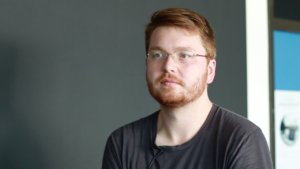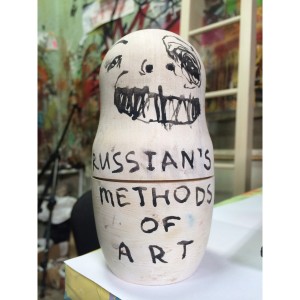I guess, like as we were talking before, there is this kind of real-life presentation and also this mediated staging on the internet and this documentation for the future. And we really try to play with it. A lot of our like performance documentation is kind of pre-staged like so- doing rehearsal etc. So, like we really play with like what is live and what’s experience and what is mediated, I guess. And then, yeah how it translates into the future also. But I guess, it’s like very current like, I guess, people are really aware of the image making these days, no? We use a variety of media in some way for this documentation. So, we use like- like different filming methods, like- let’s say we use 360-degree documentation and like, we use a phone documentation, we use like a professional camera documentation. So, like, we’re just interested, how these images perceive differently. Like, how- because of the media, I guess, that you choose. And like, we’re interested in these distorted images also. Like in glitches, like that appear like when you use like livestreaming etc. I guess livestreaming was interesting for us, because it shows exactly how like the performance from the performers’ point of view. And I guess this is like, when we spoke about agency, like of people representing themselves, like speaking for themselves. Rather than having this kind of like documentation from the outside. Like this gaze that comes on to them. A lot of the performances from this Reading with a Single Hand strand have been livestreamed before. This is the first one maybe that hasn’t. But we kind of really wanted of keep the gaze within this space. We kind of wanted to play more with this idea of really like this really contained, really intensive experience for the audience. We also kind of use the mirrors a lot. And I feel like this, I don’t know, this avoiding of looking at the audience, like eye contact between the performer and the audience but somehow very intensive connection between the three of them, was really important for us in this iteration. It’s also because of how they worked together and how kind of close they became during this piece, I think. From the beginning it was interesting for us, to like explore these dichotomies, like we started- like we’re interested in gender like in this dichotomy like of male, female, nature, culture and public, private and like we’re kind of interested, how to like recreate this intimacy within a public space, I guess. And this livestreaming helps them in some way. It helps them not to be here, somehow present, it helps them to be like distance, like this kind of- like a gaze from the audience also. But in the same time, we’re really here kind of in this togetherness and this somehow-, I don’t know, this narrative, that they are co-creating as well, I think. Which this- because they share, they always take turns with the documentation, they share the device that does the livestream, they pass it to each other. So, it’s always like kind of also negotiating the power within the group. And always they are giving, you know, handing over the responsibility or the agency to the next person.

















